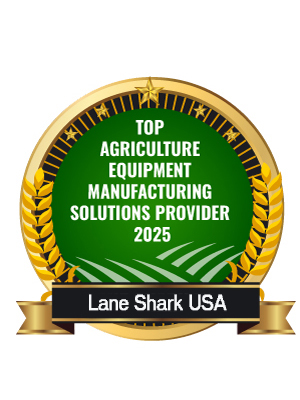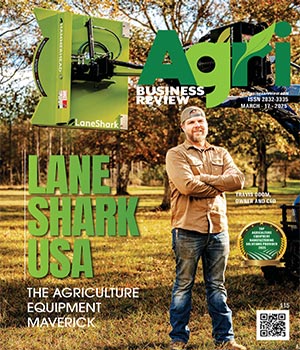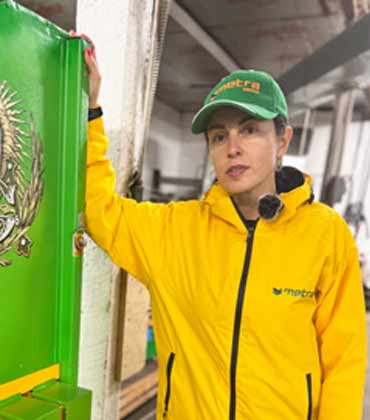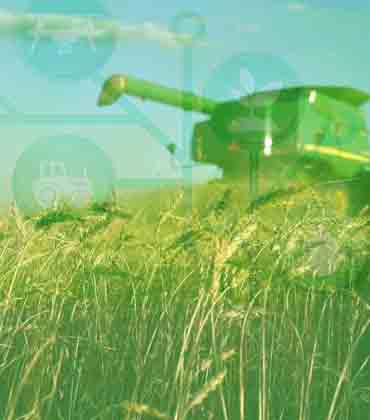Thank you for Subscribing to Agri Business Review Weekly Brief
Agri Business Review: Specials Magazine
Across rural America, property upkeep can often feel like an uphill battle, with overgrown trails, encroaching property lines, and tangled hunting paths. However, a refreshing solution is taking root. Lane Shark USA is revolutionizing how landowners tackle their toughest challenges, transforming once-exhausting chores into manageable tasks and redefining what’s possible for property maintenance. Lane Shark USA was founded on the principle of solving real-world problems with ingenuity. Its brush cutters and accessories empower landowners to maintain their properties with unparalleled ease and efficiency. The story of Lane Shark USA is deeply personal for its owner and CEO, Travis Odom. Driven by a desire to provide his father with a safer, more stable job close to home, Travis conceptualized a brush cutter that would ultimately reshape land management. Reflecting on the initial spark for the project, Travis shares, “I wanted my dad to have something to do without having to travel across the country for work.” What began as a family project soon grew into something far bigger than Travis had imagined. In those early days, his mother, Sandy, played a key role in bringing the vision to life, helping him design the company’s first logo—a shark-shaped design where the letters formed the body. Meanwhile, his stepfather, Terry Marsh, was instrumental in testing the prototypes, ensuring each design was practical and effective. Their contributions helped shape Lane Shark USA from a concept into a reality, setting the foundation for its growth. Before Lane Shark USA entered the market, options for clearing overgrowth were either prohibitively expensive or physically demanding. Landowners often relied on chainsaws and pole saws, leading to days of grueling labor, exposure to hazards like snakes, and the constant risk of injury. Recognizing this gap, Lane Shark USA developed an affordable, user-friendly solution that allows landowners to clear brush safely and efficiently from the comfort of their tractor seat.
Grain cleaning has been more about endurance than innovation. Farmers have spent countless hours battling outdated machinery, adjusting screens and trying to outsmart an age-old problem. But what if one adjustment—just a simple shift in airspeed—could change everything? That’s exactly what Metra Grain Cleaners has reimagined with its Aerodynamic Grain Cleaner. It separates grains based on their weight and aerodynamic properties, effortlessly removing dust, chaff, immature kernels and fungal-compromised grains without the need for screens or manual recalibration. “No More Downtime, Just Results” Harvest season is a race against time. The last thing farmers need is to pause operations to swap out screens, clear out clogs or fine-tune settings for every different grain type. With Aerodynamic Grain Cleaner, those interruptions become a thing of the past. This single, compact system seamlessly handles a diverse range of crops—from delicate sesame seeds to robust chickpeas—without requiring manual adjustments. Its on-site mobility eliminates the need for extra transportation, allowing farmers to process grain right where it’s harvested. And because scalability matters, Metra offers models that process anywhere from 80 to 8,000 bushels per hour, making sure both small farms and large-scale operations benefit from its efficiency. “Our goal is to find the perfect balance between practical needs and financial sense. This isn’t just a machine. It is an investment designed to improve your yield and maximize your returns,” says Anna Smirnov, vice president. Consider the story of Tony, a North Carolina-based corn grower and organic feed supplier for a major chicken processing company, who discovered his corn had Aflatoxin level soaring to 64 parts per million (ppm). With the standard tolerance range between 10 ppm, his contract with the meat processing company was at serious risk. Leveraging Metra’s advanced grain cleaning technology, he could reduce the antibody levels to 3-4 ppm in a single run. What seemed like a lost crop became profitable just by switching the grain cleaner.
Top HAY Accumulator Systems Manufacturer
Modern agriculture is evolving rapidly, bringing new challenges. One significant pain point for farmers in the equine industry is handling small square bales. In the early 2000s, the hay industry faced a growing disconnect between equipment and market needs. Most bale-handling systems were built for heavier 60-pound bales, while horse owners preferred lighter 40- to 45-pound bales. This mismatch left farmers struggling with inefficiency, rising labor costs, and a shrinking labor pool. Tackling these issues head-on, Norden Mfg emerged as an innovator, transforming the industry. The company introduced the Norden Accumulator, an automated bale-handling system that minimizes the need for manual labor, improves efficiency and profitability, and increases scalability. “Our equipment allows farmers to manage thousands of bales with precision and ease, ultimately reducing costs and boosting productivity. The Accumulator frees farmers by automating traditionally labor-intensive tasks, allowing them to focus on expanding their operations without the usual headaches associated with increased workloads,” says Kenneth Kuhns, owner of Norden Mfg. Scalable Solutions for Farms of All Sizes One of the most impressive aspects of Norden Mfg’s product line is its scalability. Whether a farm produces 1,000 bales annually or 140,000, Norden Mfg offers right-sized solutions tailored to the operation’s needs. Farmers can start with a smaller 10 bale system and easily scale up to an 18 bale system as their business grows—without requiring a proportional increase in labor or significant additional investment. For instance, a farm producing 10,000 bales per year might initially invest in the company’s system to alleviate labor shortages. As the farm grows and production increases to 30,000 or more bales annually, the same equipment can continue to meet demand, transforming a small operation into a thriving, profitable business. This adaptability gives farmers a competitive edge in a constantly changing market.
CXO INSIGHTS

Navigating Food Safety Challenges
Riaz Ahamadeen, VP of Quality/Food Safety & Regulatory for North America, Oatly[NASDAQ: OTLY]
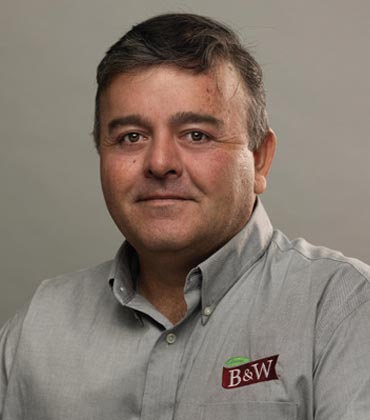
Technology - Agriculture's Most Powerful Tool
Cesar Rosero, Vice President of Production, B&W Quality Growers

The Synergy of Seed and Agronomy: A Critical Approach for Modern Agriculture
Rob Dunlop, Vice President, North America Seed, Nutrien Ag Solutions

The Case for More Variety in Agriculture and Diets
Christina Skonberg, Head of Sustainability & Mission, Simple Mills

Cultivating Innovations in Cannabis Agriculture
Michael Towey, Senior Vice President of Production and Infrastructure, Good Day Farm
IN FOCUS
The Impact of Government Support on the Farm Equipment Market
The farm equipment market is experiencing significant growth due to government policies
Use Cases of Agriculture Equipment in Ensuring Productivity
The latest technologies save time and labor while promoting better water infiltration and soil aeration, which are crucial for healthy crops.
EDITORIAL
The Impact of Modern Farming Equipment on Global Food Production
Agriculture has always been the backbone of human civilization, evolving through centuries to meet the demands of a growing population. The transformation of farming practices has been largely driven by advancements in agricultural equipment, which have significantly increased efficiency, productivity, and sustainability in food production. From the rudimentary tools of ancient times to the sophisticated machinery of today, agricultural equipment has undergone remarkable innovation. The plow, once a simple wooden instrument drawn by oxen, has evolved into high-powered, GPS-guided tractors capable of plowing vast tracts of land in a fraction of the time. Similarly, the sickle, once wielded by hand for harvesting crops, has been replaced by modern combine harvesters that can cut, thresh, and clean grains simultaneously, reducing both labor and time. One of the most significant benefits of modern agricultural machinery is the enhancement of productivity. Mechanized equipment allows farmers to cultivate larger areas with greater precision, reducing manual labor while maximizing yield. Advanced irrigation systems, such as drip and sprinkler irrigation, ensure optimal water usage, conserving this vital resource while improving crop health. Furthermore, precision agriculture—powered by satellite imaging, sensors, and artificial intelligence—enables farmers to make data-driven decisions regarding soil health, fertilizer application, and pest control, thereby minimizing waste and increasing efficiency. Agricultural equipment has played a pivotal role in transforming farming from a labor-intensive occupation to a technologically advanced industry. As innovations continue to unfold, ensuring accessibility and affordability of modern machinery will be key to achieving food security and sustainability for future generations. Embracing these advancements while addressing existing challenges will pave the way for a more productive and resilient agricultural sector. In this edition, we have featured Lane Shark USA. The company was founded on the principle of solving real-world problems with ingenuity. Its brush cutters and accessories empower landowners to maintain their properties with unparalleled ease and efficiency. Lane Shark USA’s product lineup reflects its commitment to meeting diverse customer needs. It includes a range of tractor attachments and hydraulic solutions designed to enhance the power and versatility of compact and subcompact tractors.

